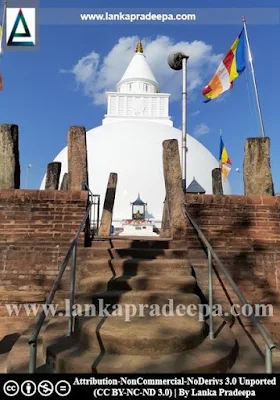Kiri Vehera Viharaya is a Buddhist temple situated in Kataragama in Monaragala District, Sri Lanka.
History
The Kiri Vehera Stupa is believed to have been founded by Mahanaga [(c. 3rd century B.C.) Paranavitana, 1933]. Brahmi Letters (masons' marks) belonging to about the first century B.C. have been found on some of the bricks fallen down from the dilapidated Stupa dome (Nicholas, 1963; Paranavitana, 1933).
Inscriptions
Two inscriptions have been found near the Kiri Vehera Stupa (Paranavitana, 1933).
Kiri Vehera slab inscription of circa 2nd century A.D.
This slab contains five lines of writing inscribed vertically from the top downwards (Paranavitana, 1933). It records the enlarging of the Stupa (the modern Kiri Vehera) and the construction of entrance steps by a monk named Nanda (Nada-tere) residing at Dakavahanaka in the village Kadahavapigama (Nicholas, 1963; Paranavitana, 1933).
Slab inscription of Mahadalimahana
This inscription is on a slab lying on the pavement of Kiri Vehera. It has been broken into four fragments and one of them was missing but has been found today (Paranavitana, 1933; Uduwara, 1991). The inscription contains 13 lines of writing and the letters resemble that of the Tissamaharama Slab (Paranavitana, 1933). The inscription records a donor named Mahadali Mahana raja (King Mahadathika Mahanaga) who according to Paranavitana, is a local ruler of Rohana (Paranavitana, 1933). The Kiri Vehera Stupa is referred to in this inscription as "Mangala-maha-seya" of Kajaragama-raji-maha-vehera (Nicholas, 1963; Paranavitana, 1933; Uduwara, 1991).
References
1) Nicholas, C. W., 1963. Historical topography of ancient and medieval Ceylon. Journal of the Ceylon Branch of the Royal Asiatic Society, New Series (Vol VI). Special Number: Colombo. Royal Asiatic Society (Ceylon Branch). p.51.
2) Paranavitana, S., 1933. (Edited and translated by Wickremasinghe, D.M.D.Z.; Codrington, H.W.) Kataragama inscriptions. Epigraphia Zeylanica: Being lithic and other inscriptions of Ceylon: Vol. III. Printed at the Department of Government Printing, Sri Lanka (Ceylon) for the Archeological Department. pp.212-225.
3) Uduwara, J., 1991. Kataragama slab inscription. Epigraphia Zeylanica being lithic and other inscription of Ceylon: Vol. VI, Part 2. Archaeological survey of Ceylon. Sri Lanka. pp.216-220.
3) Uduwara, J., 1991. Kataragama slab inscription. Epigraphia Zeylanica being lithic and other inscription of Ceylon: Vol. VI, Part 2. Archaeological survey of Ceylon. Sri Lanka. pp.216-220.
Location Map
This page was last updated on 6 June 2022
A short note for local school students
කතරගම කිරි වෙහෙර
කිරි වෙහෙර ශ්රී ලංකාවේ මොණරාගල දිස්ත්රික්කයේ කතරගම පිහිටි බෞද්ධ සිද්ධස්ථානයකි.
ඉතිහාසයක්රි.පූ. 3වන සියවසේදී පමණ මහානාග විසින් කිරි වෙහෙර ඉදිකරන්නට ඇතැයි සාම්ප්රදායිකව විශ්වාස කෙරේ. ගරාවැටී තිබූ ස්තූප ගර්භයෙන් ගැලවී තුබූ ගඩොල් මත ලකුණු කොට තිබූ ක්රි.පූ. 1වන සියවසට අයත් බ්රාහ්මී සළකුණු හමුවී තිබේ.
ශිලා ලේඛනකිරි වෙහෙර ස්තූපය අසල තිබී ශිලා ලේඛන ද්විත්වයක් හමුවී ඇත.
ක්රි.ව. 2වන සියවසට පමණ අයත් කිරි වෙහෙර පුවරු ලිපියකඩහවාපිගම (ග්රාමයේ) දකවහනක විසූ නන්ද නම් ථෙර විසින් දාගැබ (වත්මන් කිරි වෙහෙර) විශාල කිරීම හා එහි ප්රවිශ්ඨයන්හී පියගැට ඉදිකිරීම පිළිබඳ සටහනක් මෙම සෙල් ලිපියෙහි සඳහන්ය.මහදලිමහන පුවරු ලිපියසෙල්ලිපිය කොටස් 4කට කැඩී ගොස් ඇත. පේලි 13කින් සමන්විත සෙල්ලිපියෙහි අකුරු තිස්සමහාරාම පුවරුවට සමානය. මෙම ශිලා ලේඛනයෙහි කිරි වෙහෙර හඳුන්වා ඇත්තේ කාජරගාම රජ මහා වෙහෙර ලෙසයි.


